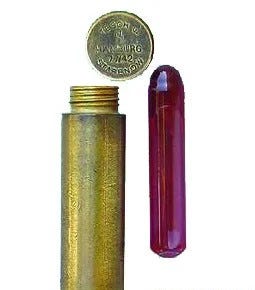Cyanide C≡N: A toxin used in medicine (B12)
More to this toxin than meets the eye. And a scary family story.
Cyanide is found in nature, both in plants and in certain environments. It was not just found as a suicide capsule in the helmet bands of SS officers. I do have a story about that one.
🌱 1. Plants (Cyanogenic Glycosides)
Many plants produce compounds called cyanogenic glycosides, which release hydrogen cyanide (HCN) when the plant tissue is damaged (e.g., by chewing). These are common in:
Cassava (manioc, yuca) – Especially the bitter variety.
Fruit seeds – Such as apple seeds, apricot pits, peach pits, cherry pits, and plum pits. Bitter Almond; seeds and fruit stones.
Borage and flaxseed oil.
Lima beans – Especially wild varieties.
Bamboo shoots
Sorghum and millet
🔬 These plants use cyanide as a defense mechanism against herbivores. As an accidental ingester humans can become victims as well.
🌋 2. Volcanic Activity and Wildfires
Cyanide gases can be released in volcanic emissions or forest fires, as part of the breakdown of nitrogen-containing organic material.
🔥 3. Burning Buildings
Cyanide gases can be released in burning building, as part of the breakdown of nitrogen-containing materials in building material and also furniture, etc.
That is why firetrucks carry cobalamin for emergent administration to save lives of firefighters.
🌊 4. Certain Bacteria and Fungi
Some bacteria, algae, and fungi naturally produce cyanide as a byproduct of metabolism or as a defensive compound. For example:
Pseudomonas aeruginosa (a type of bacteria) can produce cyanide.
Certain fungi involved in plant decay or symbiosis can release this compound as well.
🐜 4. Insects and Animals
Some insects and animals are known to produce or accumulate cyanide:
Millipedes, certain butterflies, and insects like burnet moths produce cyanide to deter predators.
💊 6. A bottle of Extra Strength Tylenol
The Tylenol murders in the early 1980s was a nationwide plot by someone to destroy the reputation of McNeil Labs a subsidiary of Johnson & Johnson (J&J) pharmaceuticals by lacing capsules of Tylenol with cyanide, it is still considered an open case with a lot of unresolved questions:
🧪 Forms of Naturally Occurring Cyanide
Hydrogen cyanide (HCN) – A volatile, poisonous gas.
Cyanogenic glycosides – Non-toxic until enzymatically broken down to release HCN.
Metal cyanide complexes – In some soils or water bodies, bound to iron or other metals.
Sodium Cyanide (NaCN) and Potassium Cyanide (KCN)
My uncle came back to America after WWII ended from flying a B-24 bombers over Nazi Germany with a war souvenir: a SS helmet and it remained in his attic for many years. When his infant son was bored one day he brought it down for Jr. to play with and while in the kitchen, his son reached into the headband of the old helmet and pulled out a cyanide capsule hidden inside. When my uncle returned from the kitchen, he found all this red dye all over Jr.’s hands… it was from the outside of the cyanide capsule hidden in the headband of the souvenir and Jr. could possibly have been one of the last victims of the European Theater of war. By the Grace of God Jr. did not put that in his mouth. Crazy scary story.
The use of cyanide as a preservative in vitamin B12 shots (cyanocobalamin); Manufacturers in an attempt to lengthen shelf life (Shelf Lives Matter) bound the poison and the antidote together. Since cobalamin is the agent that reverses the harmful effects of cyanide, it is cute method to use. I would rather not use that in my patients. Hence the use of Methylcobalamin (and not just to avoid cyanide) as a methyl donor and added benefits to human health.
# # #







First in a 2 part series on B-Vitamins: https://imahealth.org/courses/whole-body-health-with-dr-saleeby/lessons/whole-body-health-episode-38-vitamin-b-part-1-b1-b6/ Part II will be coming up soon, keep an eye out for it.
Thank YOU, Dr. Saleeby, for this interesting story and update! Because I take B vitamins, including B-12 every day, this info is certainly a warning of what form of B-12 NOT to take…always, the Methylcobalamin is the correct form! Many thanks!